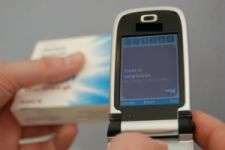Countering the counterfeiters -- smart technology to secure product supply chains

(PhysOrg.com) -- Counterfeiting is a huge problem. Luxury goods are a favourite target, but so are vital products including medications and aircraft parts. European researchers have created a new way to stem the tide.
Have you ever been tempted by a “designer” watch or handbag at an amazingly low price?
If so, you’ve been brushed by the burgeoning market for counterfeit goods. Nobody knows exactly how many billions of euros this market represents, but the number of counterfeit items seized at European borders surged from 100 million in 2004 to 250 million last year, including luxury goods, intellectual property such as music and movies, and potentially life-threatening ersatz pharmaceuticals and aircraft parts.
The aptly named EU-funded research project SToP (for Stop Tampering of Products) took on the challenge of applying state-of-the-art technology and systems analysis to safeguard vulnerable products. They’re now able to offer a suite of solutions from sophisticated RFID (Radio Frequency Identification) tags and handheld readers to software that helps businesses assess their security needs and determine how cost-effective SToP would be for them.
“We needed a new tool against counterfeiting,” says Harald Vogt, coordinator of the SToP project. “What we demonstrated is an effective combination of technology and organisation, an overall system that can be implemented by businesses without extensive training or extra costs.”
Searching for a systemic solution
The researchers realised that tackling a problem as widespread and multifaceted as product counterfeiting required an understanding of the vulnerabilities of products from the drawing board to the customer’s hands.
Working with consortium partners that include leading aircraft, pharmaceutical and luxury-goods manufacturers, the researchers discovered that a fundamental shift was required from after-the-fact criminal investigations and legal action to system-wide prevention.
“The main business of the security departments of most businesses has been working with police and local authorities to try to shut down internet sites and actual shops selling counterfeit products, yet that addresses only a very small part of the problem,” says Vogt.
Instead, he says, SToP’s approach was to analyse and model an item’s journey from design to delivery, and then integrate appropriate security measures throughout the process. “By applying the right technology at the right time, we can make the security department’s job much easier,” says Vogt.
In addition to developing tailor-made RFID tags and user-friendly readers that work well in the factory and all along the supply chain, SToP also created systems and software to help companies assess their security needs and calculate costs, plus software for seamless product tracking and authentication.
Field trials and business applications
The SToP researchers tested their RFID capabilities on one of the toughest products they could find - a high-end designer wristwatch.
“Luxury goods are very sensitive with respect to their design.” says Vogt. Hiding an RFID chip in a luxury leather product might not be too difficult, but incorporating one invisibly into a watch, and passing radio-frequency signals through the watch’s metal case was a significant challenge.
“The designers had to prepare space for the RFID tag and adapt the other parts of the watch to accommodate it,” says Vogt. “All that’s visible from the outside is a small hole in the metal casing, which turned out to be necessary to allow the RFID tag to be read.
With a unique RFID tag integrated into each watch, the item’s authenticity can be checked as it moves from the factory through the wholesale and retail supply chain, up to the moment it is handed over to a secure and satisfied purchaser.
Vogt was particularly pleased to find that incorporating this new level of security into a luxury product such as a watch did not add significantly to the product’s cost.
“Designing and assembling this kind of item is a very complex task, and the RFID tag is really just another component to provide space for and incorporate into the production process,” says Vogt. Design-to-delivery trials of luxury watches and leather goods showed that RFID tagging and tracking added surprisingly little to the cost of the products. “It turned out to be quite manageable,” says Vogt.
Vogt views the project’s field trials authenticating aircraft parts as very important, but still preliminary. They used the delivery of a limited number of parts to a single aircraft to test the technology, but more importantly to create a formal model of the entire supply process.
Understanding that process, Vogt says, is crucial to providing a high level of security.
“Our work with the airline industry laid the foundation for this strategic process analysis and modelling, which in the end will give more results than a single technological achievement could,” says Vogt.
The SToP project has already spurred commercial applications. Project partner SAP, one of the world’s leading software suppliers, created a new company called Original1, headquartered in Frankfurt, Germany, which will use SToP-inspired technology and approaches to deliver product authentication and anti-counterfeiting services worldwide.
“This new company is not bound to promote a single technology,” says Vogt. “It can propose the technology that best fits the product, and provide the tracking and authentication infrastructure. That makes it a very appealing business model.”
More information: SToP project - www.stop-project.eu/
Provided by ICT Results
















